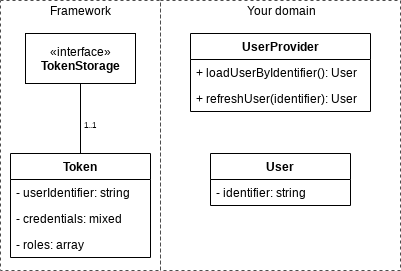Symfony Security: Is Security about User management?
Symfony 2 completely renewed Symfony. Symfony 3 gave us a completely refactored and improved Form component. Symfony 4 gave us a renewed dependency injection experience. Let’s fix Security in Symfony 5! To start with: The concept of users in security.
The Security guide has 36 official documentation articles. This means it’s by far record holder. The Dependency Injection component is on place two with just 26 articles. Also, a book about Security is in leanpub’s top selling Symfony list (congratz Joshua!). The Security component needs fixing! What can we do?
What’s the problem?
Users are your domain logic. Yet, the component forces your user to implement
UserInterface. This requires you to define a salt (mostly empty),
username (probably return $this->getEmail();) and password (I hope you
aren’t using tokens in your API?).
You can decouple the security user from your domain one.
Yet, doing so means that you have to write a custom service to get the
domain user in your controller/services. All Security getUser() methods will
return the Security user and not the domain one. That means writing custom core
functionality to fix a problem in the component.
What is Security without a User?
A lot actually. The core of the Security component needs no users. Token objects (not related to API tokens) contain all necessary information about the user. After authentication, the user object is saved in this token, together with the credentials and the roles.

At this point, you might wonder why there are two objects: Token and User. They both contain the username, user roles and password… I agree, we can remove one of the two concepts.
The user object also creates another problem: The user object is part of the authenticated token. This means it’s serialized when the token is stored in the session. This means your user object has to be serializable: It needs to remove plain text passwords, resources and other stuff you don’t want to serialize.
Is there a way to fix it?
Yes: remove users. Wait, whaat?! Security is all about getting a user, right? Well, I don’t think so. Security is about securing your resources (pages, files, etc.). That’s all security should provide as a base. To do this, a unique identifier is needed to identify who is asking permission to access. This means we get the user feature as a very nice bonus, but it isn’t the main goal of Security.
With that in mind, I’ve described why users cause problems. I’ve also already shown what other unique identifer Security has besides the User object: Tokens. Actually, everything Security needs is already in these tokens, so no need for user objects in the component!
However, being able to typehint for UserInterface in the controller is great.
Removing users from the component make this is impossible: The Security
component can no longer relate the token with a user object that you created.
To fix this, tokens can save a plain text identifier for the user. You can set this to the id of your domain user. The component can provide some automatic loaders of this Client entity based on the ID, like the current user providers.

How does this Impact my Code?
As a base, this means your user object does no longer contain anything from the Security component.
Before
1
2
3
4
5
6
7
8
9
10
11
12
13
14
15
16
17
18
19
20
21
22
23
24
25
26
27
28
29
30
31
32
33
34
35
use Symfony\Component\Security\Core\User\UserInterface;
class ApiUser implements UserInterface
{
private $email;
private $roles;
public function __construct($email, array $roles)
{
$this->email = $email;
$this->roles = $roles;
}
public function getUsername()
{
return $this->email;
}
public function getPassword()
{
return 'none';
}
public function getSalt()
{
return null;
}
public function getRoles()
{
return $this->roles;
}
// ...
}After
1
2
3
4
5
6
7
8
9
10
11
12
13
14
15
16
17
18
19
20
21
class User
{
private $email;
private $roles;
public function __construct($email, $roles)
{
$this->email = $email;
$this->roles = $roles;
}
public function getEmail()
{
return $this->email;
}
public function getRoles()
{
return $this->roles;
}
}When you want to use getUser() functions, you only have to implement a simple
interface:
1
2
3
4
5
6
7
8
9
10
11
use Symfony\Component\Security\Core\IdentityInterface;
class User implements IdentityInterface
{
// ...
public function getIdentifier()
{
return $this->id;
}
}As you can see, this all becomes way more flexible. Your user only needs to have some unique identifier and all other information is in the tokens.
The benefit of this is that the Security component only needs to serialize the token in the session. This means your user object or whatsoever doesn’t need to be serializable, doesn’t need to erase credentials, cetera.
Take Home’s
- Security isn’t about the user
- Users are your domain, a framework should not interfere with that
- Identifiers link objects with the same meaning
Of course, this post is just proposing ideas. I’m sure there will be difficulties to integrate this into the Symfony code. But I believe it is necessary to rethink what’s needed in the Symfony Security component. Integrating the Security component should be easier. Reducing classes that need to be modified to use Security helps with this.